The Land Of China -- Explore by Province
 |
 |
Hong Kong
Hong Kong's dynamism is unforgettable. From the vantage point of Victoria Peak, overlooking the world's busiest deepwater port, you can see a city geared not only to making money but feeling good about it. At night, it's like looking down into a volcano. Despite its British colonial past, Hong Kong has always stuck to its roots and the culture beneath the glitz is pure Chinese. That didn't stop locals from feeling apprehensive about being re-united with the motherland when the British handed the colony back to China in 1997, but their unease has largely evaporated.
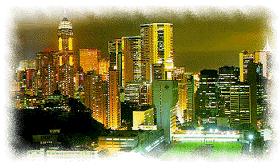
|
Lying at the southeastern tip of China, Hong Kong, the "fragrant harbor," adjoins the province of Guangdong (Canton) and is just south of the Tropic of Cancer. The total land area of Hong Kong is 1,078 square kilometers, comprising Hong Kong Island (77.5 square kilometres); Kowloon (45.5 square kilometres); and the New Territories, including 235 outlying islands (955 square kilometres). Today Hong Kong has become a great international trading post, a powerful manufacturing base, and one of the world's largest financial centres.
The population of Hong Kong in 1994 was 6,061,400, of which almost 95 per cent is Chinese. Chinese and English are the official languages. Cantonese is the most widely spoken Chinese dialect, though Mandarin, Shanghainese, and other dialects are also spoken. Many people, especially in shops, hotels, and service industries, speak English. Hong Kong has a subtropical climate.
Hong Kong Island
Every visitor to Hong Kong Island makes the trip to Victoria Peak, which has one of the most spectacular views in the world. It is also a good way to orient yourself to Hong Kong's sometimes confusing geography. Another major tourist attraction is Aberdeen, on the southern side of Hong Kong Island, where 6000 people live or work on junks anchored in the harbour. Sampan tours of the Aberdeen Harbour are definitely worth the expense. The other major draw is the floating restaurants.
The most popular beach is Repulse Bay, also on the southern side of the island, but it gets extremely crowded on weekends. Stanley, with its laid-back atmosphere, is another good spot for escaping Hong Kong's hustle and bustle.
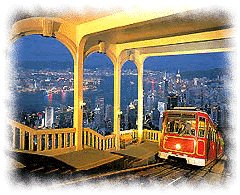
|
Victoria Peak
Victoria Peak is also called "Tai Ping Shan". It is the highest point in Hong Kong at 554 meters where toursits can enjoy a spectacular view of the entire Hong Kong Island, the harbor, and Kowloon, It is one of the best views in the world. The Peak itself offers delightful walks amid mountain greenery. The modern, three-storey Peak Galleria, which is beyond the Peak Tramway, houses shops and restaurants and recreational facilities. Next to the Peak Galleria, there is a newly established seven-story Peak Tower, which is designed as a viewing point, as well as an entertainment and educational center.
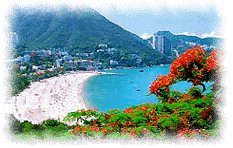
|
Located on the south side of Hong Kong Island and which surrounded by up-market residential apartments is Repulse Bay Beach. This place is the most beautiful and most popular beach in Hong Kong. Here, visitors can stay in one of the finest resort suites of the East the Repulse Bay Hotel. The beach is busy all the time, offering all kinds of services - food, drinks, beach tent rental, chair rental, and lifesaving classes. The most popular attractions on the beach are two huge statues of deities - "Kwun Yum" and "Tin Hau", both are protectors of the fishermen. Many also like to walk to Deep Water Bay and Aberdeen along the waterfront of the beach.
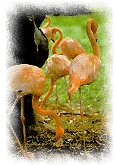
|
The Hong Kong Zoological and Botanical Gardens were established in 1864 and are constructed in formal Victorian features, comprising a wrought-iron bandstand and an unusual greenhouse. The Zoo was added in 1975 and contains many exotic species of birds. There is a popular spot in the early morning for devotees of "Tai Chi Chuan" who practice their exercises in the gardens. The former French Mission Building is a 150-year-old Victorian-style building, which is located nearby the gardens. There is also a good view of the Government House - the residence of Hong Kong's Governor.
Kowloon
Tsim Sha Tsui, at the tip of the Kowloon Peninsula, is the territory's tourist ghetto. It consists of one square kilometer of shops, restaurants, pubs, and camera stores.
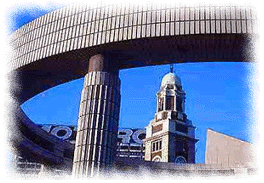
|
Song Dynasty Town
The town situated in Kowloon is an imitation of the Song capital depicted in the famous scroll "Riverside Scenes at Qingming Festival". It was built in 1979 and covers an area of 5,500 square meters. When tourists visit the town, they can walk along the bank of a small river that winds through the town. The river is flanked on both sides by stores, temples, and residences, all in ancient styles and with shop assistants and residents clad in Song costumes. Here, visitors are able to see Song officials on inspection tours, "wealthy" people returning to their homes, and wedding ceremonies proceeding in typical Song customs. These vivid and interesting presentations allow visitors to muse over things of the remote past.
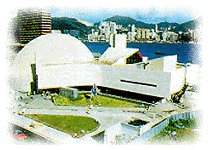
|
the Space Museum
The Space Museum covers an area of 80 thousand square meters. The theater was built in 1980 and is a dome-shaped building that consists of three sections: the Hall of Space Science, the Hall of Astronomy, and one of the world's largest and most technically planetariums, the Space Theatre, where thrilling wide-screen Omnimax and Skyshows are presented. Headphones for translation in English, Cantonese, Mandarin and Japanese are free provided.
Outlying Islands
There are 234 outlying islands, many of them not much more than uninhabited rocks. However, Cheung Chau, with an area of 2.5 square kilometers, has 20,000 residents and is fast developing into a mini Honolulu, although there is no motorised traffic. Lantau, the largest of the islands with an area of 142 square kilometers, has a population of 30,000, a 933 meter peak, and a 70 kilometer walking trail, and yet the island has avoided many of the development excesses of other islands. It is home to several important monasteries, including Po Lin Monastery with its enormous bronze Buddha. Thanks to the new airport development, Lantau is now connected by bridge to the mainland. Other islands worth visiting include Lamma, Peng Chau, Poi Toi, and the uninhabited Tung Lung Chau.
Cheung Chau
Cheung Chau (which means "Long Island" in Chinese) is a tiny dumbbell-shaped island. It has an area of only 2.5 square kilometers yet a population of about 22,000 inhabitants.
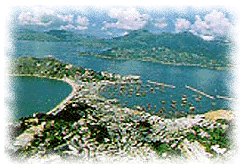
|
Lantau
Lantau Island (Tai Yue Shan in Chinese) is the largest island of Hong Kong. In contrast to Cheung Chau, it has an area of 142 square kilometres but a population of only 25,000. More than half of the island is designated as country parkland, with well-marked trails, picnic, camping, and barbecue sites, and good beaches.

|
the Giant Statue of Tian Tan Buddha, made of bronze, is located on Lantau Island. The statue weighs 250 tons and has as height of 26.4 meters with a base 7.6 meters high. This is the world's largest bronze statue of Sukyamuni. The base is modeled on the structure of the Temple of Heaven (Tian Tan) in Beijing. Therefore, it is called Tian Tan Buddha.
Ocean Park
The Ocean park, also known as the best park in Southeast Asia, is built on a mountainside. The park is Southeast Asia's largest entertainment and leisure complex, and its outdoor escalator system is the second longest in the world. Visitors can choose to either escalator or cable car up to the headland.
The upper part, named Nanlangshan Park, has the Wave Cove, a man-made, power-operated marine game recreation center on the mountain top.
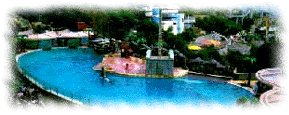
|
New Territories
Although a third of Hong Kong's population lives in new towns constructed in the New Territories, the area has some scenic escapes, including the Sai Kung Peninsula in the east, which is an unspoilt playground for hikers, campers, swimmers, and boaters. Bird-watchers head to the Mai Po Marsh; cyclists and walkers head to Plover Cove Reservoir; hiking enthusiasts set out on the 100-kilometer-long MacLehose Trail, which spans the New Territories from Tuen Mun in the west to Pak Tam Chung in the east. Shui Tau, a walled village on the outskirts of Kam Tin, is one of several small communities in the area famous for its carved roofs and traditional style Chinese houses.



 Chinese Culture
Chinese Culture